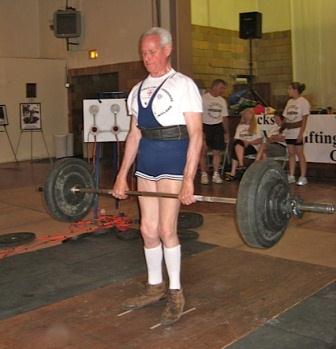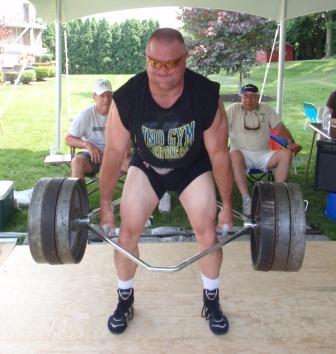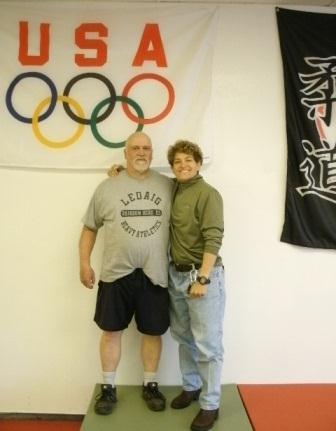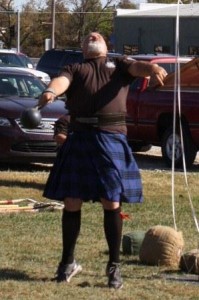by Al Myers

Dennis Mitchell competes in every meet wearing a singlet. This picture is from the 2011 USAWA National Championships.
One of the issues that has presented itself recently in the USAWA is the issue of the “official dress” in USAWA competitions or events. The USAWA has always been very lenient in what lifters wear in competitions. We allow lifters to wear tshirts and shorts, unlike most other lifting organizations. Most other lifting organizations I have competed in don’t allow a lifter to wear shorts and tshirt, but require the lifter to wear a singlet for competition. The only thing we insist on is that the lifters don’t wear supportive gear, like knee wraps or super suits. The thoughts of this go back to the ideas of our founder Bill Clark, who felt that lifting in shorts and tshirts is acceptable. I don’t have a problem with this either, but this “relaxed dress code” has lead to even more relaxed dress, and lifters have been wearing long sleeve tshirts, sweatshirts, sweatpants, and even jeans in competitions! I think part of this is the “change of times” in everyday life. It used to be that businessmen dressed in suits and ties for work everyday. Then along came casual Friday, and before we knew it EVERYDAY is casual Friday, and now I go into businesses and see people wearing shorts and tshirts to work! What has happened? It has been a gradual trend of decline in the acceptable code of dress. Now that is happening in the USAWA! I guess this is showing my age, because I still want to LOOK like a weightlifter in a competition, thus the reason I always wear a singlet. Most of the lifters my age or older do the same. I look at guys like Denny Habecker, Scott Schmidt, Dennis Mitchell – and these guys always look the part of weightlifters at meets by wearing weightlifting singlets, instead of some ratty old tshirt and sweatpants.
I’m going to go over some of the rules on official dress, which comes straight from our USAWA Rulebook.
SECTION VI. EQUIPMENT
2. The lifting uniform may be a one piece suit or it may consist of shorts and a shirt. The lifting uniform must not provide any support that would aid in lifting.
3. Upper body must be covered by a one piece suit, shirt or both. No tank tops are allowed. If a one piece suit is worn, the straps must be over the shoulders.
4. Lower body must be covered by a one piece suit or shorts. No sweat pants are allowed. The suit or shorts must not extend lower than the base of the quadriceps muscle. An undergarment is allowed to be worn under the suit or shorts, but must not provide any support that would aid in lifting.
5. Headgear of any kind is not allowed except for religious purposes. This would include stocking caps, ball caps, headbands, or any other covering of the head.
6. Lifting gloves are not allowed.
7. Lifting straps are not allowed.
8. Braces or supports on any part of the body are not allowed. This would include neoprene elbow and knee sleeves. An exception to this rule may be made by the officials if the lifter has proof that it is medically necessary.
9. Socks must extend no higher than the bottom of the kneecaps and must not be an aid in lifting.
10. Suitable shoes or slippers must be worn. They must not provide an unfair aid in lifting.
11. A belt may be worn and must not exceed 12 centimeters or 4-3/4 inches in width.
12. The lifter may be required to have his/her gear, which may include shoes, lifting belt, wrist wraps, and lifting attire inspected at weigh-ins. Approval of proper dress code will be determined by the Meet Director. Lifting attire which contains inappropriate language or images, is too revealing, sloppy in appearance, or deemed otherwise inappropriate by the weigh-in official or Meet Director is a violation of the USAWA dress code.
These rules pretty much “lay it out” what is expected. I truly believe that most of the violations are due to lifters just not being aware of what is required to meet the USAWA dress code. Very rarely do I feel there is any malicious intent by a lifter to “cheat” by violating these requirements. There is reasons behind all this and let me explain a few. Wearing long sleeve shirts is not allowed because some lifts require the elbows be locked. A long sleeve shirt could hide this infraction. The same thing applies to wearing sweat pants – if the knees are covered it makes it difficult for the official to tell if the legs are straight in lifts that require this. Headgear, like loose stocking caps or ball-caps, might impair the ability of an official to determine if a lifters head is flat on the bench, or against a wall in lifts like the strict curl. Obviously knee sleeves can be “lift enhancing”, but even if they were loose and non-supportive, they could undermine an officials view of the legs just like sweatpants would.
Read over article 12. Our rules allow a meet director to approve the proper dress, and if wanted, a meet director could disallow inappropriate dress. I had to do this at the National Championships where a young lifter was wearing tight fitting spandex shorts (like biker shorts) under his singlet. This undergarment was in violation of rule number 4, because it extended below the base of the quadricep. No harm was done, and he just took it off when I asked him. He was not aware that this was a violation. But in this meet the Zercher was contested, and wearing a tight fitting undergarment this low on the quadriceps would allow a lifter to rest the bar on the shorts instead of on the legs alone, which I feel would give an unfair advantage.
My feeling is that all lifters should be required to wear singlets in competition, and not just shorts and tshirts. When I was throwing in the Highland Games kilts were required by all athletes in competition (outside of novice classes). All throwers “looked the part” of being a Scottish Athlete this way. By requiring singlets in the USAWA, all lifters would also “look the part’ of being a weightlifter. I welcome input and discussion on this topic in the USAWA Discussion Forum. I would like to know everyone’s opinion on this.
Speaking of improper dress code – it is time for another quiz. There are a number of pictures in our Rulebook demonstrating the USAWA lifts. Among these pictures there is a NUMBER of improper dress code violations (which obviously were overlooked in competitions because most of these pictures came from competitions). I have counted them up and was surprised at the number. For anyone who emails me the correct number of violations regarding the USAWA Dress Code among the pictures in the Rulebook I will send you a free USAWA Water Bottle. The deadline for this quiz is when I get back from the World Championships in Australia.



